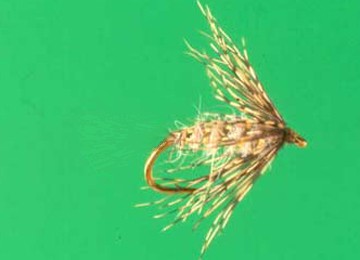On The Fly
"Fly tying is a school from which we never graduate"
 TYING NEWS
TYING NEWS
The RFF beginner and intermediate tying classes continue
through March. Each class has had 8 to 10 students and each week we cover a
couple new patterns and techniques. In no time at all, we will have a whole
new batch of enthusiastic thread wrappers. Johnny Hale and myself have
enjoyed sharing our skills and knowledge with the next generation of tiers.
The Southern Oregon Fly Tiers had their monthly meeting
February 25th at the Lions Sight & Hearing Center. The tying classes were
invited to this meeting along with several new members. The club continues
to grow and there's plenty of room for any and all interested tiers. We meet
the 4th Wednesday of every month at 7 p.m.
Just a reminder that the annual Northwest Fly Tying Expo
will be held in Eugene at the Lane County fairgrounds, Saturday, March 20th,
from 9 a.m. to 5 p.m. It's a premier event and worth the time to see over
150 talented tiers remind all of us just how much there is to learn.
 PATTERN OF THE MONTH -
PATTERN OF THE MONTH -
Hare's-Ear Soft Hackle
Hook: Tiemco 200R, sizes 12 to 18
Thread: Brown 8-0
Body: Dark hare's-ear dubbing, starting
above the barb & tapering forward.
Rib: Fine copper wire
Thorax: Dark hare's-ear dubbing
Hackle: 2 to 3 turns of brown Hungarian partridge flank,
swept back.
The Hare's-Ear Soft Hackle is one of the great generic
bug patterns. In many sizes it can be used as an emerging mayfly in rivers,
or a Callibaetis emerger and damsel fly nymph in lakes, or just a good
general search pattern by itself or as a dropper. Most often it is thought
of as a caddis emerger because of its fine, impressionistic copy of an
emerging caddis pupa.
The easiest and simplest way to tie one is to use a Tiemco
200R hook and tie a short, carrot-shaped body of hare's mask dubbing with a
rib of copper wire or flat gold tinsel on larger sizes. Start the body
above the hook barb, taper it, rib it, and then tie it in a slightly fatter
thorax. Ahead of that is a sparse, oversized soft hackle of brown partridge
or brown hen neck hackle on larger sizes. When the fly is wet the hackles
should lie back past the hook bend. Size 18 & 20 are unweighted but on
size 16 and above I put a few turns of skinny lead wire under the thorax.
Caddis pupae can be pretty hefty, big-headed bugs,
especially the large ones, so a variation called the Bead-Chain Hare's Ear
Soft Hackle can be tied for this imitation. It's the same pattern except
dark bead-chain eyes with figure eight wraps of hare's mask dubbing through
them, are used for the head. The silhouette is more like the real caddis
pupa and the eyes give just enough weight to sink the fly an inch or two
under the surface in current. This variation can be tied size 16 through 12.
TYING TIPS - Making variegated chenille
Many times finding a source for that special color
variegated chenille may be difficult or even impossible. You can make your
own easily by twisting together a strand of each color needed to make
instant variegated chenille that stays together even when the twisting
pressure is released. Another bonus is that twisted chenille makes a much
tighter full body. Your inventory problem is also solved. Simply buy the
basic colors to make any combination desired.
Tie One On,
Dan Kellogg (you can contact me at FLYGUY@EZNORTHWEST.COM)